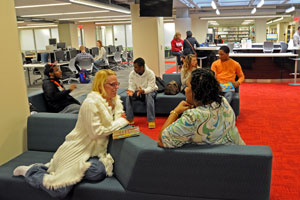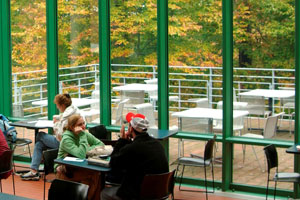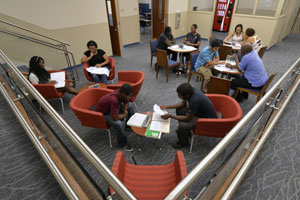What is STEM?
What is the College doing to improve STEM education?
Delaware County Community College, along with its President, Dr. Jerry Parker, has assumed a leadership role in promoting STEM education. Here is what the College is doing:
- Dr. Parker served on Pennsylvania Governor Ed Rendell’s Leadership Team to implement the “Pennsylvania STEM Initiative,” a grant-funded project to prepare more students for careers in STEM fields and to recruit, retain and retrain Pennsylvania’s workforce in these critical fields.
- Dr. Parker is playing a leadership role in The Greater Philadelphia Regional Compact for STEM Education as it works to develop a unified plan for the region.
- The College has invested in a new $60 million STEM Complex, consisting of the STEM Center for the study of mathematics, technology, science and engineering and the Advanced Technology Center for study and hands-on training in technical fields. Both facilities are equipped with the most modern laboratories, technology and equipment so graduating students are well prepared to enter today’s high-tech workforce or to continue their educations.
Our commitment to STEM education – and our investment in STEM facilities and programs – makes Delaware County Community College the ideal place to pursue your studies in one of the many STEM fields.
STEM is an acronym for Science, Technology, Engineering and Mathematics.
The effort to enhance education in the STEM fields extends well beyond Delaware County Community College. It’s part of a national initiative to prepare Americans for today’s and tomorrow’s jobs – and to ensure that our country remains a leader in technology and innovation.
Why does STEM education matter?
To compete for 21st century jobs, students need an education with a solid grounding in the STEM fields. The U.S. Department of Labor projects that 15 of the 20 fastest-growing occupations by 2014 require significant science or math training. Unfortunately, even as the number of jobs requiring a STEM background is growing, the number of students majoring in these fields is declining.
Too few students who go on to college are pursuing the desired courses. Interest in science, technology, engineering and math falls short of employers’ needs. From 2004 to 2014, employment in science and engineering is expected to grow at nearly double the rate for all occupations… "
The two fastest growing occupations: Biomedical engineers…likely to grow by over 70% from 2008 to 2018…and network systems & data communications analysts, up 53%. The number of graduates in those fields is growing, but not fast enough.
~ The Kiplinger Letter, December 18, 2009
If this trend continues, American companies will not be able to fill their positions. Perhaps most important, without a skilled workforce, our country will find it more and more difficult to compete in the global economy.
Concern about this situation has been growing for years. In a 2005 report, Rising Above the Gathering Storm, the National Academies (Advisers to the Nation on Science, Engineering and Medicine) described an ambitious program to ensure our country’s economic leadership by making math and science a priority in our schools. One of the report’s key goals is to increase the pipeline of students prepared to enter college and complete a degree in science, engineering or mathematics.
Today, national, state and local organizations, including Delaware County Community College, are working together to strengthen STEM education at all levels.
By the Numbers
We need to invest and nurture the industries of the future, and we need to train our workers to compete for those jobs. Nations around the world, from Asia to Europe, have already realized this.”
~ President Barack Obama, Speech to the Business Roundtable, February 2010
In 2001, only 8% of all degrees awarded in the U.S. were in engineering, mathematics or the physical sciences.
The U.S. ranks 20th internationally based on our share of graduate degrees awarded in engineering, computer science and mathematics.
National Action Plan for Addressing the Critical Needs of the U.S. Science, Technology, Engineering, and Mathematics Education System
National Science Board, 2007













